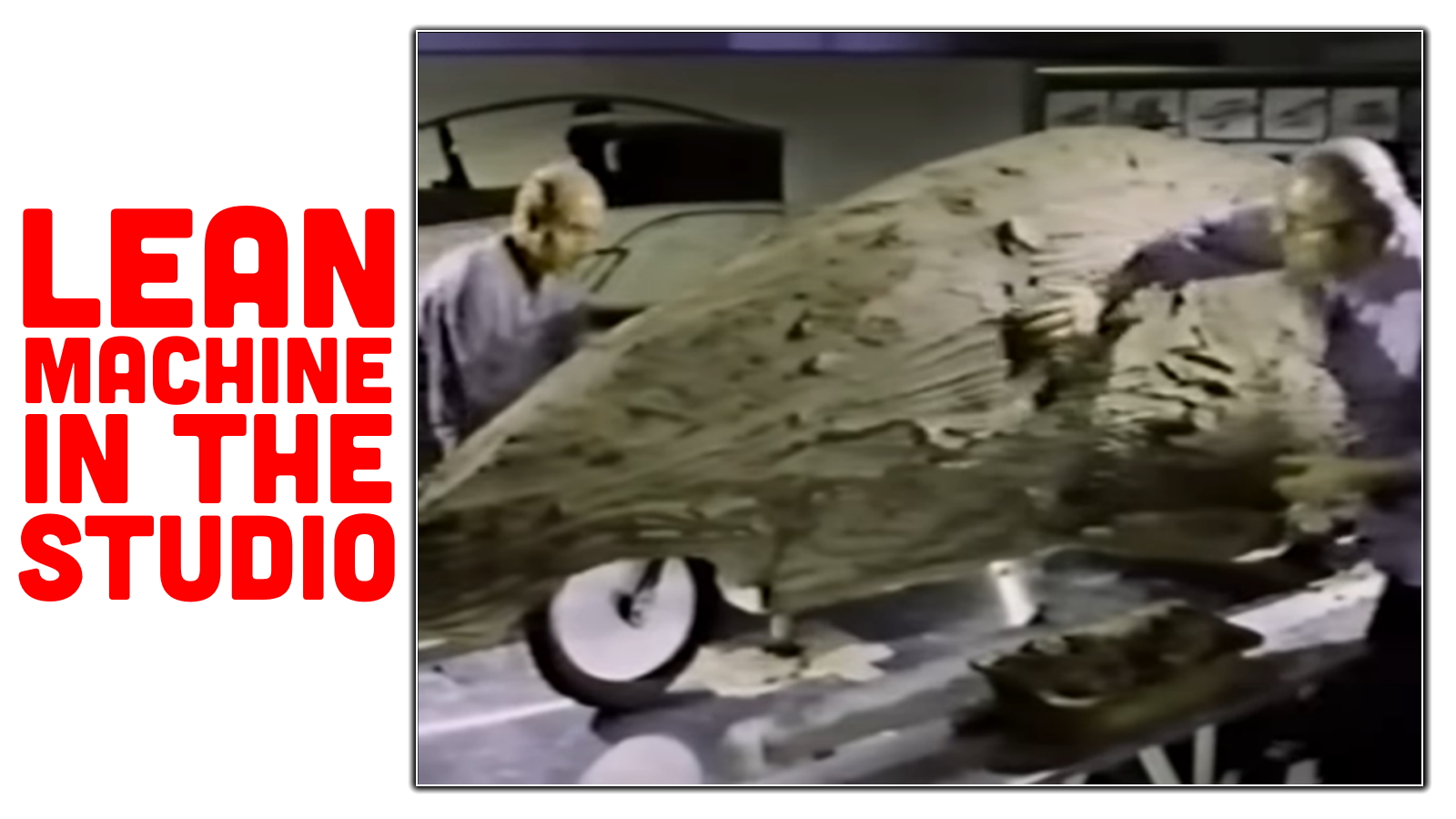Sitting at 103 inches long on a 72-inch wheelbase, the Lean Machine was longer than you’d expect. It’s almost the same length as two Peel P50s, although its length is somewhat mitigated by its short 47-inch height. Despite looking a bit like a marital aid, the Lean Machine had a drag coefficient of 0.35. Not great, but at least the frontal area was small. Plus, the whole thing was so light that according to Road & Track, GM claimed 40 mph cruising fuel economy of 120 mpg from the Lean Machine’s 185cc Honda engine. Making that fuel economy figure even more impressive was the fact that GM didn’t unveil the Lean Machine until 1982, meaning that this thing was under development at the same time GM was churning out Monte Carlos powered by smog-choked 305 small block V8s with computer-controlled Quadrajet carburetors. Sure, they’re both cars, but they really couldn’t be more different. Unsurprisingly, power from the 185cc engine goes to the rear wheels, although the process of getting it to the road is as unusual as it is joyous. The Honda engine was attached to a five-speed semi-automatic gearbox, which sent power through a Peerless lawn tractor differential to a pair of custom axles. At the end of each axle sat a boat trailer tire, not exactly performance rubber by any stretch of the imagination. The whole powertrain sat in a dedicated rear pod because the Lean Machine was all about leaning into corners, as explained through a montage of humans, birds, elephants, and seals. So why is leaning a good thing? Well, think about how a normal road car exhibits body roll when chucked into a turn. Centrifugal force transfers weight to the outside tires, resulting in body roll, sidewall flex, and the driver flopping around in the seat like a beached carp. If a car’s too tall and too narrow, it can simply tip over during spirited cornering. Three-wheeled vehicles with one wheel in the front can also tip over from centrifugal force, as GM demonstrated by putting a grown-ass man on a tricycle and making him fall off of it. As Winchell put it, “This is a problem common to anything that moves. Except for things like turtles and snakes, nature’s solution was to provide for weight transfer by leaning or cambering into the turn.” Motorcycles also lean while turning, although their wheel arrangement brings up concerns regarding static stability. As per Winchell, “That’s why a horse has two in front and two in the rear, instead of one in the front and one in the back like a bicycle.” There are likely some other reasons why horses don’t have one hoof in the front and one hoof in the back, but Winchell’s comment gets the drift of things. By putting two wheels firmly on the ground at all times and letting the front wheel and driver’s pod lean, the Lean Machine is really the best of both worlds. During the Lean Machine’s development, GM cooked up a variety of intriguing prototypes from an extreme mobility scooter to what was essentially a motorcycle with two outrigger wheels. Some of these prototypes make the Lean Machine almost look normal, which is an astonishing feat by GM’s engineering team. Once a general mechanism was sorted, the design team came in to figure out appearances, going so far as to sculpt a full-size clay model. It’s not particularly hard to imagine this clay work occurring around the time the C4 Corvette was being styled. Who knows, perhaps some of the canopy styling rubbed off on GM’s flagship product. Leaning cars have been tried again since GM crafted the Lean Machine. There was the Mercedes F300 Life Jet, a concept with a name like a medical instrument. Then there was the Carver, a bit of tilting Dutch madness that Formula 1 champion Jenson Button once desribed as “possibly the weirdest thing I’ve ever driven.” However, unlike the Carver, the Lean Machine didn’t rely on gyroscopes or any sophisticated electronics to enable tilting. Hell, it didn’t even rely on unsophisticated electronics. Instead, two pedals in the footwell operated lean-limiting cables. Since the driver’s feet would be busy ensuring that the Lean Machine doesn’t tip over too far, throttle and brakes were on the handlebars, just like a motorcycle. In addition, a shift lever between the driver’s legs operated a five-speed semi-automatic gearbox. All of this sounds extremely complicated to operate. Get it all right, and you could pull GM-claimed 1.2g of lateral acceleration at max attack despite the Lean Machine’s hockey puck-sized rear tires. Get it all wrong, and you’d be granted a FoMoCo part number as you became a new hood ornament for a 1979 Lincoln Mark V. Aside from a pair of bump stops to prevent from tilting past 50 degrees, there wasn’t much safety aboard the Lean Machine. Still, what’s excitement without a bit of danger? Believe it or not, GM actually built three Lean Machines, although one wasn’t exactly functional. The only narrow-tail model made was for static display at Disney’s Epcot Center, part of the GM World of Motion display. The two functional models were the well-known 185cc version and a much beefier model that stepped power up from around 15 horsepower to a whopping 39 horsepower. According to Hemmings, the high-output Lean Machine was good for 100 mph, which sounds a bit terrifying considering the tire situation. Then again, watching the Lean Machine dice it up with standard automobile traffic feels exciting, like the little vehicle’s been plucked straight out of George Jetson’s garage. Of course, the Lean Machine never made it to mass production, but it did pick up a role alongside Wesley Snipes in silly dystopian Cyberindustrial film “Demolition Man”. Hey, if you want a car that screams sci-fi, it’s hard to do better than a tilting three-wheeler. Lead photo credit: GM There’s no headlight I could see in the demos, I assume they had plans for one. Given the era, maybe a pop up headlight would have been just the thing it needed. Up next- how about an article on GM’s Aero 2000 and the other World Of Motion exhibits at EPCOT? And Demolition Man is a cheezball wonderful movie…(just on the downside of) peak Stallone. And b/c Autopian, the Olds 442 he salvages in the future for the requisite chase is beautiful. I’ll see myself out. In short, quit shitting on GM for holding back EVs. They’ve done more to push them forward over the years than anyone other than maybe Tesla. There are plenty of valid reasons to criticize GM, this is not one of them. On the other hand, how about a CanAm Spyder with a closed cockpit? Anyhow, I’ve still got the brochures for the Lean Machine that I got that day. I was so sure I’d be driving one of those when I grew up. Thanks for the nostalgia. See the article about the Goggomobil. Assuming roughly equivalent horsepower, and a price for the Lean Machine at about 80 percent of a Goggomobil (Say $12,000 for the Lean Machine and $15,000 for the Goggomobil) which would you rather live with for 48 months* as your sole mode of transportation? Payments (48 mo) : (Just the car – no sales tax or fees etc included) Goggomobil: $342 Lean Machine: $275 Or a used car? $12,000 worth of used car and $3,000 extra to to defray the higher cost of gas. Hmmmm *Why 48 month loan and not 60? Because I pity the fool who has to put up with either of these for 60 months of daily driving.





